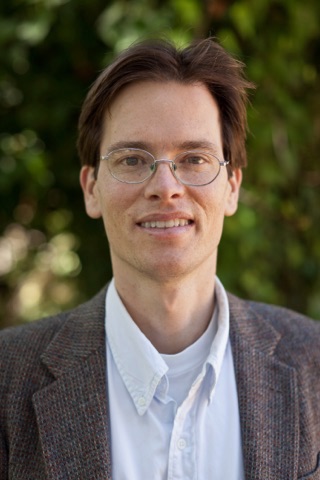Three years ago, Elliott Campbell made headlines with research that suggested that existing U.S. cropland could feed most of the nation's population with food produced within 50 miles.
Those eye-popping findings, published in Frontiers in Ecology and the Environment, delighted the "local food" movement. For Campbell, they underscore the importance of testing the viability of environmental initiatives that have captured the popular imagination.
"I take these dreamy ideas and see if the numbers play out," said Campbell, an associate professor of environmental studies and the inaugural recipient of the Stephen R. Gliessman Presidential Chair in Water Resources and Food System Sustainability. "That study was exciting, because it showed how much potential there is. Right now only about 1 percent of food is produced within the 'local food' parameters."
Campbell, who joined the faculty in July, is an environmental engineer who is drawn to research at the nexus of food, water, and energy. The Central Coast is a perfect "laboratory," because he is particularly intrigued by opportunities that pop up when urban and agricultural areas are in close proximity.
Building on the "local food" work, Campbell is eager to explore whether reclaimed wastewater generated by cities could be used to recharge aquifers that have been depleted by agriculture. "The Central Coast is unparalleled when it comes to using reclaimed water for edible crops," said Campbell. "We need to reuse water, and we need to recirculate water."
Similarly, Campbell is interested in recirculating nutrients between cities and farms—specifically nutrients that are lost when food turns to waste.
"Forty percent of food goes to waste," said Campbell. "When we divert waste from the landfill as compost, ideally we send it back to farms. But compost is a bulky, low-value product; it doesn't make sense to transport it long distances. It needs to be generated near cities for use on nearby farms."
Campbell refers to the wastewater and nutrient recycling ideas as "circular systems," both of which are in keeping with the principles of the Center for Agroecology and Sustainable Food Systems (CASFS). Professor Emeritus Steve Gliessman, a founder of the field of agroecology, was "in the field," whereas Campbell refers to himself as a researcher who does "large-scale modeling."
"I bring something different to the campus, but I get a lot of my ideas from farmers," he said.
Campbell looks forward to collaborating with professors Carol Shennan and Daniel Press of Environmental Studies, as well as Andy Fisher, professor of Earth and Planetary Sciences and a widely recognized expert on aquifer recharge.
A native of Santa Cruz, Campbell joined the faculty from UC Merced, drawn to the Environmental Studies Department's interdisciplinary approach.
"Everybody is talking about interdisciplinary science, but this department is really doing it," he said. "It's easy to talk about it. The reality is that it's sometimes painful and unpleasant. But it's necessary, because it's at the intersection of disciplines where you have breakthrough moments."
The UC Santa Cruz collaboration among Environmental Studies Professor Michael Loik and physicists Sue Carter and Glenn Alers on the viability of solar greenhouses has caught Campbell's attention, as well. Greenhouses are energy intensive, but they can significantly boost a region's ability to produce "local food" by extending production through the "shoulder seasons" of spring and fall. What's the "sweet spot" between production and energy consumption, and how might solar power-generating greenhouses impact that calculation, asks Campbell.
"These phenomena are growing rapidly, and this is a critical time for scientists to get engaged, before things get set in stone," he said, noting that year-round food production provides the added social benefit of job security for workers.
Campbell's reach extends far beyond Santa Cruz County, however. He recently approached the California State Water Resources Control Board about a proposal to analyze the potential benefits of covering the state's aqueducts and irrigation canals to reduce evaporation, and installing solar panels to generate electricity.
"People have been talking about this for ages, but there's no good science behind it," said Campbell, noting that impacts on waterfowl and other creatures also need to be examined. These are the large, complex, interdisciplinary—and interwoven—questions that intrigue Campbell.
"We need to do some experiments to figure out the scale of this resource," he said.
Campbell's solution-oriented work attracts the attention of scientists, policy makers, journalists, and others who are looking for new ways to boost environmental sustainability.
Asked about the warm public reception of ideas that have not been demonstrated to be environmentally sustainable, Campbell says he thinks he understands it. "In the case of local food, we have a long history of doing it," he said. "It's not the dominant model now, but it's almost like instinct to say 'We can do this.' If food and people are too far apart, they will never come back together. But if they are close enough, we'll get these opportunities. We are moving toward circular systems."



